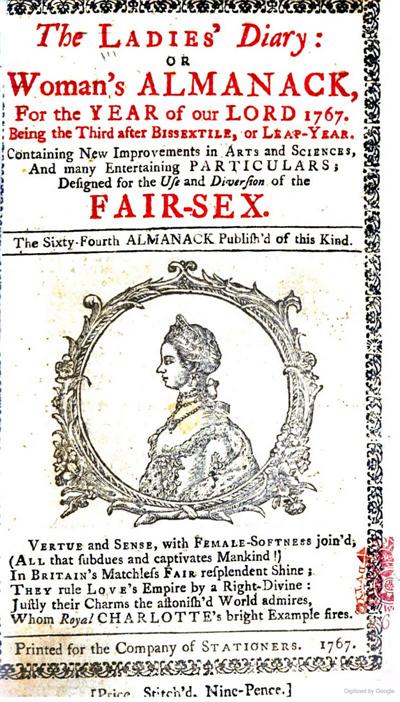 An amazing publication was conceived primarily for women at the beginning of the 18th century in 1704 and was called The Ladies’ Diary or Woman’s Almanack. What made it even more remarkable was that each issue contained mathematical problems whose solutions from the readers were provided in the next issue. One particularly sharp woman was Mary Wright (Mrs. Mary Nelson). This is one of her problems:
An amazing publication was conceived primarily for women at the beginning of the 18th century in 1704 and was called The Ladies’ Diary or Woman’s Almanack. What made it even more remarkable was that each issue contained mathematical problems whose solutions from the readers were provided in the next issue. One particularly sharp woman was Mary Wright (Mrs. Mary Nelson). This is one of her problems:
“VIII. Question 72 by Mrs. Mary Nelson
(proposed in 1719, answered in 1720)
A prize was divided by a captain among his crew in the following manner: the first took 1 pound and one hundredth part of the remainder; the second 2 pounds and one hundredth part of the remainder; the third 3 pounds and one hundredth part of the remainder; and they proceeded in this manner to the last, who took all that was left, and it was then found that the prize had by this means been equally divided amongst the crew. Now if the number of men of which the crew consisted be added to the number of pounds in each share, the square of that sum will be four times the number of pounds in the chest: How many men did the crew consist of, and what was each share?”
What makes this problem nice is that it does have a clean answer, contrary to most of the problems in The Ladies’ Diary.
See the Ladies’ Diary Problem for solutions.
(Update 5/6/2019) I don’t think I conveyed sufficiently my sense of awe that we were solving a problem posed by a woman 300 years ago, and it was as fresh and stimulating now as it was then. The durability of mathematics is truly wonderful. And equally remarkable is the capability and ingenuity of a woman living 100 years before the time of Jane Austen’s novels.
I have thought about the frequency of the astronomical problems and wonder if they are more easily solved when they were presented, because they were part of an almanac that possibly contained the necessary information. None of the essays on the subject of the Ladies’ Diary addressed that idea.
One sad aspect of the publication is that its ingenious problems attracted too many men who both posed and solved the problems. In addition, as time wore on the problems got more difficult and required more formal education in mathematics that the women did not possess. The essays on the Diary mentioned how there were relatively few math journals available to the public in the eighteenth and nineteenth centuries and this publication filled a need, even for the men.
